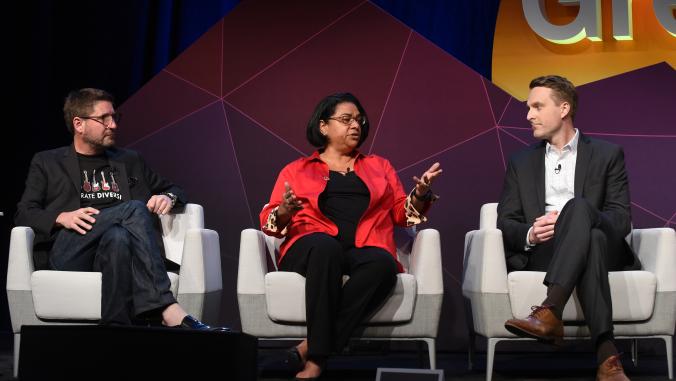How P&G, Wells Fargo finance the circular economy
Here are three approaches to harness the business opportunities in radically rethinking materials and waste.

As commodity prices rise, populations grow, natural resources dwindle and supply chains become riddled with risk, the circular economy stands out as an alternative to the limits of linear growth.
The circular economy, according to think tank Ellen MacArthur Foundation, aims to decouple economic growth from resource constraints. It is, foremost, an economic aim to design waste out of material life cycles, minimize negative environmental impacts and help companies build capital. Its widespread growth depends on rethinking business models — and investors, manufacturers and non-profits each play a role in driving circularity mainstream.
There is up to a $700 billion annual benefit for companies that move to recover materials that end up in incinerators, landfill or wastewater. But what will it take to reshape an economy in which the waste stream is the primary source of "virgin" materials — or in which waste is eliminated? And how do companies finance infrastructure that effectively "closes the loop" on the manufacturing economy?
There is not one single destination on this long journey, but here are three ways market sectors bring unique solutions towards maximizing business opportunities within the circular economy.
Private investment foots the bill
A small division of Wells Fargo is helping businesses stride towards circularity. Around 2005, according to Puon Penn, its executive vice president and head of technology capital, the bank launched an internal look at a more sustainable supply chain, which "catalyzed our thought process around how to finance sustainability in general."
The team was unable to find viable suppliers with minimal waste stream impacts to furnish its offices, so they set out to "dream up these solutions" and finance the growth and expansion of business models that promoted recycling. Working with accelerators and incubators throughout the UnIted States, Wells Fargo ran into early-market challenges.
[Learn more about the circular economy at VERGE 17, Sept. 19-21, in Santa Clara, California.]
"Circular economy products can be more capital intensive at the beginning," said Penn. "You're working on materials and products that typically have longer gestation cycles than the average market."
They also found it difficult to demonstrate the economic advantages of circular economy solutions, which Penn said is typical of the cleantech space: "Solutions can be incrementally better, but in overcoming inertia, selling something a product on 10-20 percent can be challenging."
In order for the circular business model to change corporate behavior, Penn said it's important to work with investors to develop expertise around the supply chain, so they can target specific corporate pain points rather than convince organizations to transform from the ground up.
Change is happening due to larger market forces, but focusing on specific industry solutions helps target investment where it's most needed.
There is up to a $700 billion annual benefit for companies that move to recover materials that end up in incinerators, landfill or wastewater.
"If you look at whole economic sectors, all these industries are being disrupted," said Penn. Initially, linear supply chains may be the cheaper, established option, but it introduces more risk to the supply chain.
"For interesting insights, start talking to the end user and focus on a specific sector — they have the domain expertise." And there are plenty of directions in which to innovate: Penn noted the food sector, where he says 40 percent or more food is wasted, and the polluting apparel industry.
Data, information and technology improvements make it easier for companies to reverse-engineer where they can better use scrap materials or design products for disassembly and reuse. When big corporations successfully follow these practices, others follow suit, because they "react to big companies that are building the culture of logistics."
For accelerating capital towards circular economy products, however, communication is the best lubricant.
"If organizations pooled resources and talked about challenges in order to solve problems, that's a powerful market signal with transparency to entrepreneurs that develop solutions," said Penn.
Nonprofits bridge industries
Helping corporations identify where capital needs to be deployed towards the circular economy is Closed Loop Partners, a group launched by Walmart Foundation in 2013 along with 30 recycling, consumer product and supply chain experts working to reclaim, for example, $11.5 billion in discarded packaging per year.
"Closed Loop Partners recycles in packaging waste and materials that can be recycled but have no end market," said Ellen Martin, impact and reporting specialist at Closed Loop Partners. It administers the Closed Loop Fund, a $100 million effort targeting early-stage innovations that address needs in circular business models — with the goal of deploying all the capital by 2025.
"Packaging waste is a problem that extends beyond the reach of any one company," said Martin. "Closed Loop Partners is addressing the systemic challenges we face as a society around packaging waste and turning that material into new content that companies like Unilever, P&G, Pepsi and Keurig Green Mountain [all CLP members] can use in their supply chains."
The fund is both shaking up entrenched industries to find opportunities in their waste streams and helping out the "middlemen" who have the difficult task of sorting and repurposing materials collected by take-back programs. And the finance experts working with the fund develop knowledge from understanding municipal solid waste systems to consumer goods, which is "hard to do if you're a mainstream investor," said Martin.
Circular economy products can be more capital intensive at the beginning. You're working on materials and products that typically have longer gestation cycles than the average market.
"Since we started making investments, we learned that there is robust demand for debt financing, which our below-market-rate loan fund is providing for both municipalities and recycling companies," he said.
In 2017, Closed Loop Fund invested in IntegriCo Composites, a company that creates composite railway products such as crossties, traditionally made from virgin wood. Manufacturing products from 100 percent recycled plastics, IntegriCo has diverted more than 70 million pounds of plastics since its founding. The investment helped the company expand its manufacturing facilities, improve products and create new lines of industry-specific offerings from reclaimed plastic.
"Sometimes this material doesn't make it to the market," said Martin. "IntegriCo is working with ready demand to create more products and more opportunities for industry to pull the material through the system."
Corporations are another monumental catalyst in energizing the circular economy.
"That demand pull is critical in generating a stronger, more robust market for recycled content," said Martin.
Corporations lean in
Procter & Gamble is one such company investing in its own circular solutions, transforming the way that polypropylene (PP) plastic is recycled and reused in products.
"It started with the industry need for high-quality PP, which is used in 80 percent of nonwoven material and 20 percent in packaging," said Stephen Sikra, section head of P&G, responsible for global research and development of materials science and packaging applications. "But the challenge was to find the volume that we needed, so we thought it incumbent upon us to help innovate in this technical space to take the recycling community to the next step."
They first made an internal R&D investment to find a way to recycle PP — which is gray or black and often has an odor — in an economical, scalable way.
"Our first investment was time and talent," said Sikra. P&G's John Layman found a solution, literally: A solvent, which can be recirculated, dissolves the plastic polymer. Once "contaminants" are separated out, the liquefied plastic can be produced back into pellets for consumer-grade use in electronics, construction material, food and beverage packaging and more.
Our first investment was time and talent.
The technology was patented to PureCycle Technologies, a portfolio company of Innventure, an enterprise firm that commercializes "disruptive" technology. In July, PureCycle and P&G celebrated the opening of a plant dedicated to polypropylene recycling.
"The demand far exceeds the capacity of this one facility — P&G can use all the output, but we have chosen to share it with others," said Sikra. According to Transparency Market Research, the global PP market is now $80 billion and on track to meet $133 billion by 2023.
[Learn more about next-generation transportation at VERGE 17, Sept. 19-21, in Santa Clara, California.]
Accelerating the market rests on four pillars, he concluded: The first is that consumers have convenient access to collection systems. The second is consumer participation in recycling. Third is the capacity to separate materials such as polymers and restore them to a "virgin" state. Lastly, end-market demand is critical to continued innovation.
"We are committed to doubling post-consumer plastic use by 2020; this past year we used 34,000 metric tons," said Sikra. "We're in it for the long haul. The consecutive demand really helps build the marketplace."





